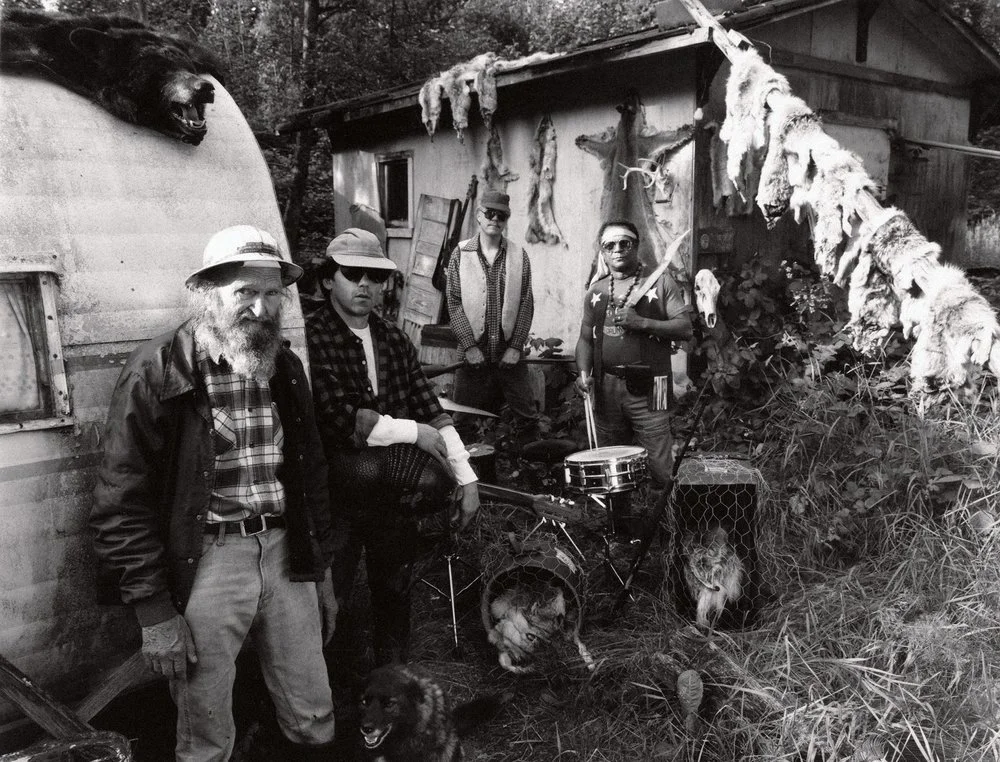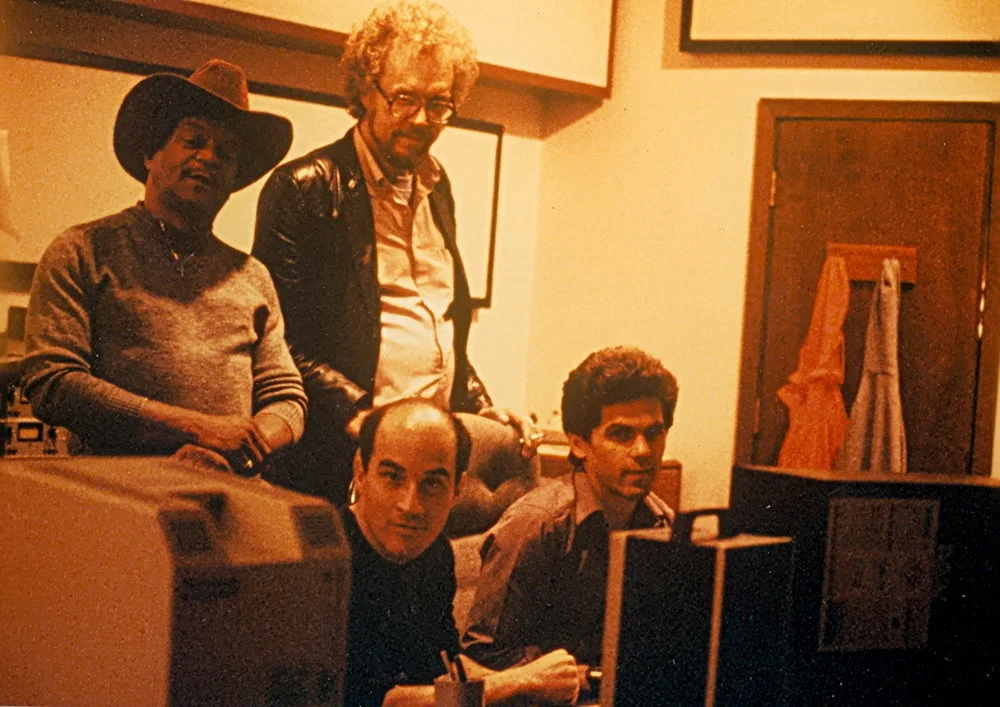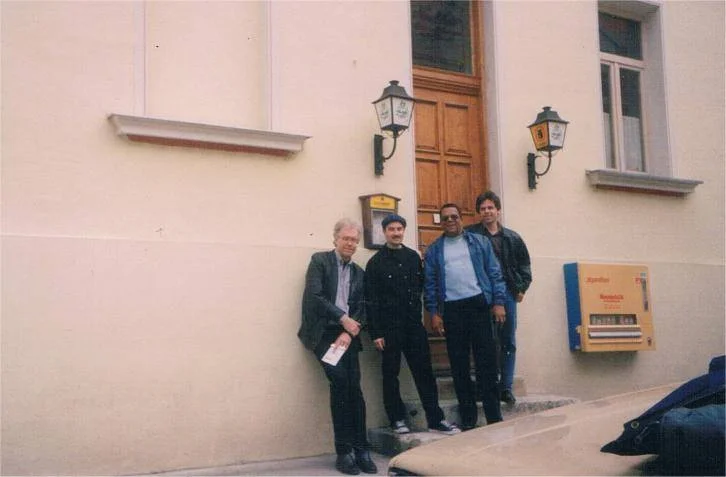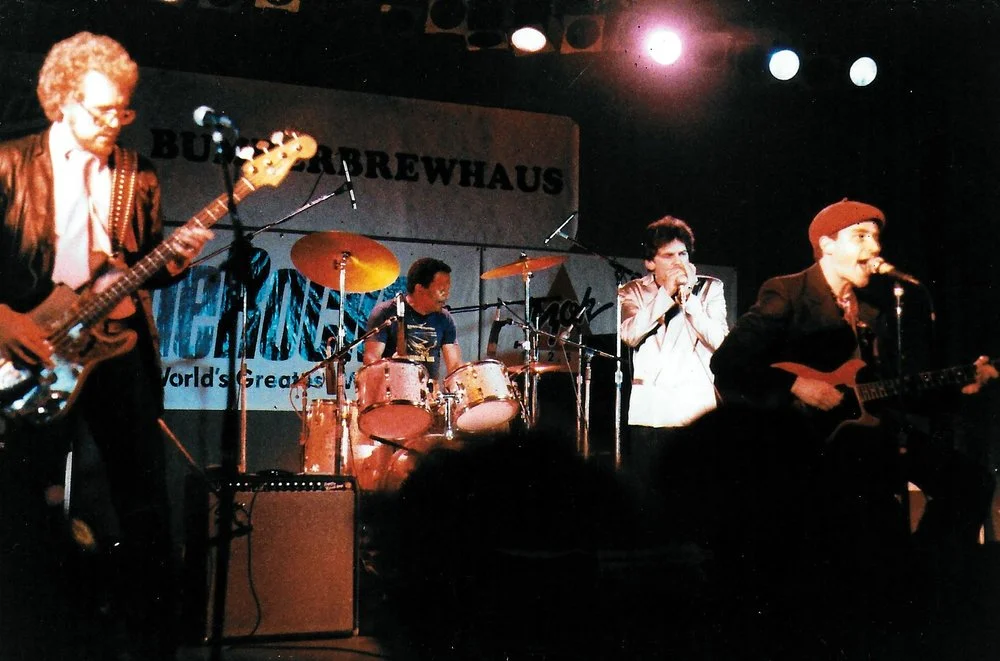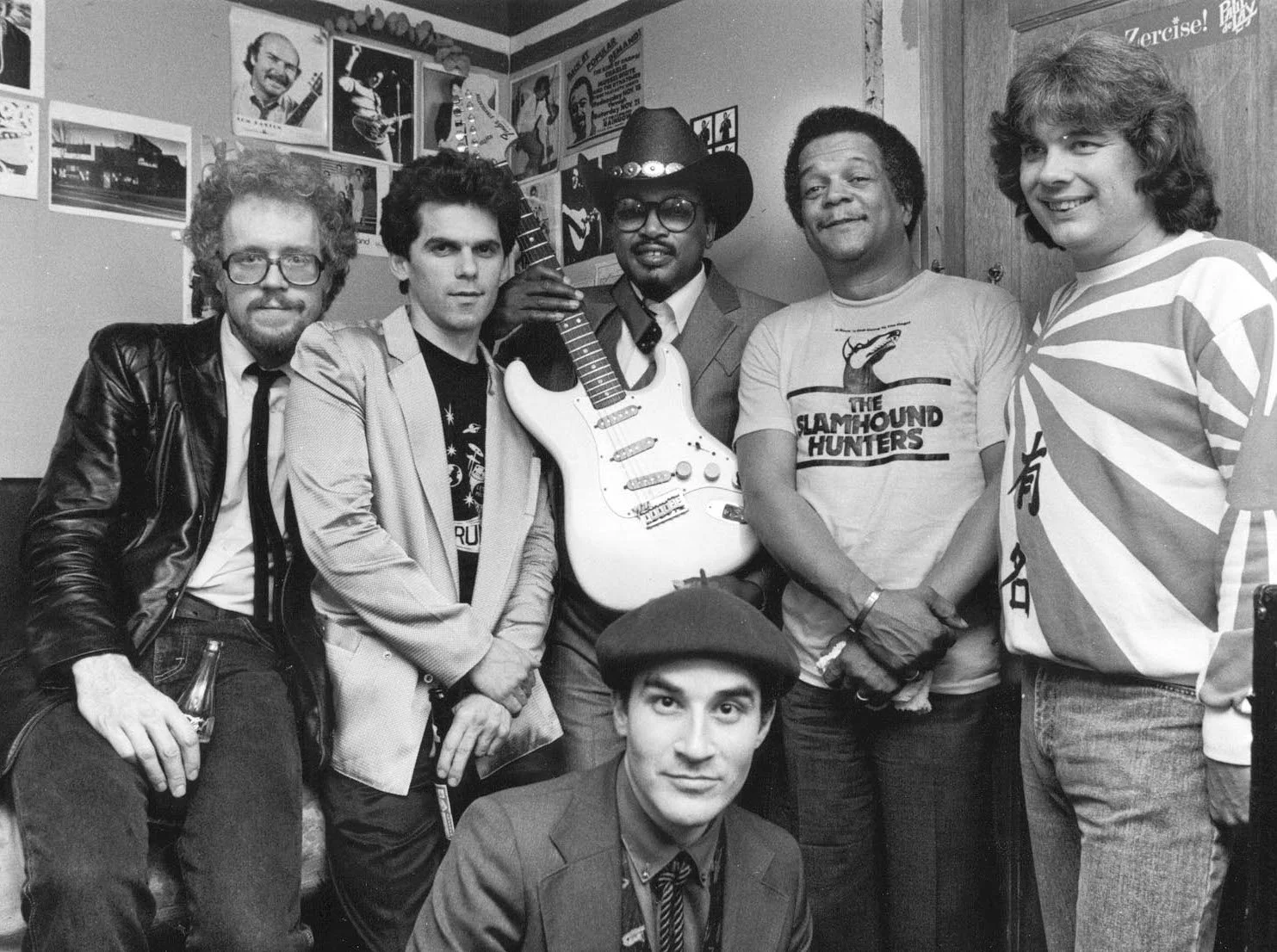seattle 1978-1990: The Slamhound hunters
Me, Greg Keplinger, Big Mama Thornton, John Seberg, Al Kaatz, Jay Thomas
Back in Seattle, I started working with various bands. I also had the chance to back up many blues greats during their visits to Seattle, including Albert Collins, Muddy Waters, Hubert Sumlin, Eddie Taylor, and Little Joe Blue. I was lucky enough to do a weekend with the legendary Big Mama Thornton. I got to the gig that night and the promoter who had hired me for the show pulled me aside to tell me nervously that she had just found out that Big Mama had a clause in her boilerplate contract stipulating that there was to be no harmonica player in the backup band. She introduced me to Big Mama and I told her that of course it was her call, but that I knew what I was doing and was familiar with her material and wouldn't get in her way. She said "Fine," and a little later the show started. I don't think she even looked at me during the first set, but after intermission she began to give me some nice solo spots. Then I found out why she didn't want harp players in the band. Unbeknownst to me, Big Mama was a fine harmonica player in her own right, and in the second half of the show she pulled out a Marine Band. We ended up playing harp duets on "Watermelon Man" and "The Work Song." What a night!
There were lots of solid venues in Seattle during the ‘70s, and the ‘80s. The G-Note Tavern booked some great blues acts and I played there many times. I got to sit in with Sunnyland Slim one night at the G-Note. The Ballard neighborhood was home to lots of bars with music, including the Backstage and the Owl Café. In Pioneer Square you could hear great blues at Larry’s Greenfront, the Pioneer Square Tavern, the J&M, the Old Timers, the New Orleans Café, and Hibble and Hyde’s.
Hibble and Hyde’s was an after-hours joint that had music until two or three in the morning. I played there the night the Seattle Supersonics won the NBA championship in 1979. The club had big picture windows behind the bandstand, and I spent most of that gig with my back to the audience and watching the entire city go beserk. I also played behind the great Eddie Taylor for three nights, opened for Charlie Musselwhite, and backed up Louisiana Red at that bar. I saw Sonny Terry and Brownie McGhee do a show there. This was late in the game and they despised each other so much that they did separate sets.
One time I was with Isaac Scott when we opened for John Lee Hooker at Hibble and Hyde’s. Isaac had a friend named Buster. Isaac and Buster were big fans of black party-record artists like Blowfly, and they considered themselves to be a pretty hilarious duo. Their thing was to do the dozens back and forth. They launched into their act in front of John Lee in the backroom of Hibble and Hyde’s. John Lee just smoked his pipe and listened to them impassively. When they paused, John Lee launched into a story about his struggles the night before after a gig in Vancouver, British Columbia. John Lee had met a very nice woman who took him home after the show. John Lee gave us all the details of his seduction of the woman, and then proceeded to describe him trying to make love to this woman while her tiny Chihauhau dog was trying to get between them and biting John Lee on his ass. It was one of the funniest stories I’ve ever heard, made better by Jokhn Lee’s delivery. Hooker really gave Isaac and Buster a lesson in comedy that night.
Back onstage, Hooker played a great set that culminated in a highly improvisational version of his anthem “Serves You Right To Suffer,” in which he sang over and over again about the pain of “living in a world of memories.” He finished the tune to an ovation from the crowd and made his way down the aisle and past those of us sitting at the tables.
An extremely attractive brunette happened to be seated alone at a table in front of me. As Hooker passed her, she hailed him, saying “Excuse me, Mr. Hooker, but that last song really moved me.” Then, as if she were generally worried about his welfare, she asked “Do you really live in a world of memories?”
Hooker was as quick and smooth as a cat as he slid into the seat next to her, put his arm around her, and confessed charmingly “Well, yes. Yes, I do. I do live in a world of memories.” It was like watching a spider with a fly.
Blues Month at the Fabulous Rainbow—those were the days
When I moved back to Seattle some friends and I rented a house in Seattle’s University District. Providentially, it was only a couple of blocks from the Fabulous Rainbow Tavern, Seattle’s best roots-music venue. Dozens of great acts played there during the ‘70s and ‘80s, including Clifton Chenier, Gatemouth Brown, Paul deLay, Buddy Guy and Junior Wells, Robert Cray (who shot his first MTV music video at the club), Curtis Salgado (I first met Curtis at the Rainbow when he played there with his early band The Nighthawks), Etta James, Lee Hooker, and many others,
Big Walter Horton brought his band to Seattle to play the Rainbow. I had a day job downtown then and the day of Walter’s show I dropped in at a nearby liquor store and there was Walter, standing in line at the checkout counter, wearing the fur hat that he often favored.
I was working a lot with at that time in a band led Brian Butler, a really talented singer and guitarist, and the two of us went to the Rainbow to hear Horton. Walter and his band (Left Hand Frank on guitar, Rick Molina on bass, and Ted Harvey on drums) really raised the roof off the joint that night. Walter was in stellar form. When he was on, no one could touch him. At the end of the night, with the crowd going crazy for more, there was a quick huddle between the club owner and Walter on stage. Then the club owner grabbed the mic and let everyone know that they had just worked out a deal to have Walter play the club again the following evening.
Awesome. Except…wait a minute—Brian was booked that night. That was our gig! So another conversation happened with the club owner, Walter, and Brian and we quickly agreed that both bands would play the next night and alternate sets, with us starting out.
I thought a lot that day about sharing the stage with Walter, but by the time I got to the Rainbow I was feeling no pressure and was just determined to do a good show and every second of the thrill of doing a gig with the best harmonica player on the planet. We jumped up and did a solid opening set, Walter and his guys got up and killed it, and we did another short set. I had some friends in the audience that night who had saved me a prime seat, and now it was time to have a couple of well-earned drinks and watch Walter do his magic.
I felt a tap on the shoulder, It was Rick Molina.
“Walter wants you to play the next set with him,” he was telling me. My brain went soft and I looked across the room to see Walter beckoning to me with a crooked finger. Somehow I floated across the room to him.
“You get on stage with the band and play through the amp,” Walter told me. “I’ll put a mic down on the floor and work that.”
I grabbed my harps and microphone, climbed onstage in a daze, took a place on stage between Left Hand Frank and Ted Harvey, and plugged in. Walter put a stand with a vocal mic a couple of feet below us on the dance floor and kicked us off. For the whole set I played fills around his vocals and he and Frank took all the solos. I could have cared less, as long as Walter Horton thought I belonged up there. I just stared down at the back of Walter’s head. listened to his amazing harmonica sound, and did the best I could.
And then it was over. I shook Walter’s hand, thanked him and Rick, and watched the band head off in their station wagon to the motel. I went home and bounced around the walls for a while and then headed out the door and paced the streets until dawn, trying to walk off my excitement, but that was a thrill that’s never worn off. Definitely my most memorable musical experience, bar none.
The Slamhound Hunters opening for Stevie Ray Vaughan at Bumbershoot (Louis X. Erlanger, Mark Dalton, me, Leslie “Star Drums” Milton
Louis X. Erlanger and I had played together in our college band, The Sting Rays. After I left New York City to return to Seattle, the Rays played a gig at a new club called CBGB in the East Village. Mink DeVille was a group that played the club, and Louis was recruited by front man Willie DeVille to take over the guitar seat in that band. Louis toured constantly with them for the next five years and played on the Mink's first three albums, which are all classics.
After Louis and Mink DeVille parted company, he and I talked about working together again. The concept, basically, was to form a band to play new original material that wasn't strictly blues but that was obviously rooted in that style. Louis moved out to Seattle and we started working on material and auditioning rhythm sections. We worked with a string of bass players and drummers in the first year. Louis was writing some pretty innovative tunes that proved challenging to drummers used to shuffles and slow blues numbers. We finally met up with Leslie Milton, who was working with a Seattle group called Blue Lights featuring John Tanner on harmonica and Barrelhouse Chuck on piano. Leslie had grown up in New Orleans learning from drummers like Earl Palmer. Leslie was a real pro who didn't have an attitude about styles--to him, it was all music, and his job was to make the groove as killer as possible. When Leslie and Mark Dalton, a great bass player who I had worked with in Isaac Scott's band, joined the Slamhounds, we finally had the right lineup to pursue the sound that we had in mind.
We were all good players. Leslie had a lot of charisma and showmanship and devised a "Star Drums" lightshow that we used on live shows that never failed to amaze audiences. Louis and I both contributed original material to the band, but Louis did the lion's share of the writing and it was his tunes and vision that really made the band unique.
The band caught the attention of Dave Corning and John Iverson, two Seattle record producers, and the Slamhounds recorded two albums for their Satin label, 4/1 Mind and Private Jungle. We started playing bigger shows. We opened for Stevie Ray Vaughan and Robert Cray in the Seattle Center Coliseum as part of Seattle's huge Bumbershoot music festival, did shows with Greg Allman, Delbert McClinton and the Righteous Brothers, and played a showcase at Tramps in New York City. One of the coolest gigs we did was opening for, and backing up, the amazing Otis Rush for three nights at the Fabulous Rainbow. Otis is one of my all-time favorite blues guitarist, singers, and songwriters, and it was an unforgettable experience to stand three feet from him while he was doing his thing. The Slamhound Hunters had a regional FM radio hit with our version of "Cadillac Walk" and Elektra/Asylum sent an A&R rep up to Seattle to record a demo with us. Louis eventually moved back to New York. Our last hurrah as a band was a tour of Europe following the release of Private Jungle was by the French label Sky Ranch.
Digital downloads of all the Slamhound Hunters’ recordings are available through the usual outlets, including CDBaby, iTunes, and Spotify.
Photo shoot for the "Private Jungle" CD: John Crossman Sr. (the original slamhound hunter), me, Mark Dalton, and Leslie Milton (photo by Frank Winterer)
Slamhound Hunters promo shot
Mixing the “Private Jungle” album
The Slamhound Hunters on tour in Europe
The Slamhound Hunters performing at Seattle’s Bumbershoot Festival
The Slamhound Hunters with Otis Rush: (left to right, background) Mark Dalton, me, Otis Rush, Leslie Milton, and special guest organist Dick Powell, (foreground) Louis X. Erlanger




